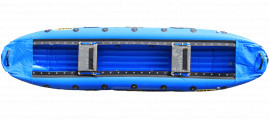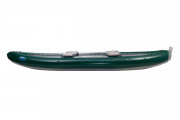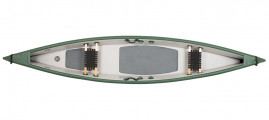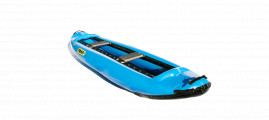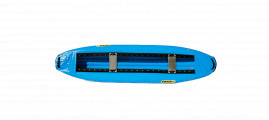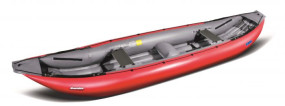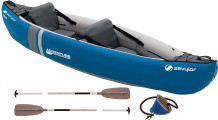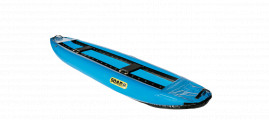Space is at a premium in so many aspects of modern life. Garages fill to the point that vehicles are relegated to the driveway. People living in cities may not have the luxury of a garage at all. And when it comes to traveling, roof racks quickly get to capacity with bikes and roof cargo boxes—after all, we want to do it all these days.
Inflatable canoes are a solution for paddlers tight on space. Their packability and portability are unparalleled. Inflatable canoes fit in an apartment closet and are easy to take along in the trunk of a car or even as a checked bag on a flight.
The inflatables category is rapidly expanding. Buyers are no longer restricted to heavy-duty whitewater boats or flimsy rubber crafts suited for pools. There is a range of blow-up canoe options, from recreational canoes to boats for remote expeditions. New technology such as drop stitching allows the inflatables to take more complex shapes, and they are made of materials durable enough to withstand heavy use. Used inflatable canoes may be available, but there are unique factors to consider when purchasing them. Below we explain these, and other tips for buying your first or next inflatable canoe.
Top picks: Best inflatable canoes for 2024
The following inflatable canoes have received the highest star ratings by reviewers in our Paddling Buyer’s Guide. See and review all inflatable canoes here.
Best Inflatable Canoes
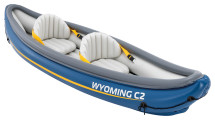
Wyoming C2
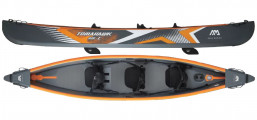
Tomahawk AIR-C
Shop inflatable canoes
Research will help inform your decision when deciding which inflatable canoe to buy. Understand the options for inflatable canoes by checking out our Paddling Buyer’s Guide. Here we have every inflatable canoe on the market, along with the product specifications, pricing and places to purchase them.
Shop by number of people
Shop by type
Shop by brand
Shopping for a used inflatable canoe?
Used inflatable canoes are not as common as their rigid counterparts. They are still relatively new, and not sold as widely. The best places to find used inflatable canoes would be through local paddling groups or specialized outdoor classifieds such as MEC Gearswap.
Manufacturers such as Sea Eagle may also sell used inflatables on their website: these are often returns or repairs and have been professionally repaired and inspected.
When buying a used inflatable, blow up the canoe to ensure that it holds air. Also be sure to check that all the parts are there—including a pump and patch kit. Chat with the current owner to get an idea of how the canoe was stored, how often it was used, and why they want to sell it.
For more tips on what to look for when selecting a used canoe, read our article How To Buy A Used Canoe.
Inflatable canoe buying guide
The inflatable canoes you’ll find vary greatly in terms of their construction, comfort and performance. Comparing a $500 blow-up floater to a $3,000 inflatable tripper is like comparing a beach cruiser bicycle to a full-suspension mountain bike. Both have their purpose, but they are nearly altogether different items.
The lower-end inflatable canoes are great for fun days at the beach or cottage. They might be uncomfortable sitting in for extended periods and should be carried into the water rather than dragged along the shore.
More expensive canoes use rigid seats for added comfort. They have reinforced PVC construction, using more rugged materials. Some use drop stitching to achieve a higher air pressure and hold a stiffer shape, giving the canoe better on-water performance and more durability.
When shopping, note the intended uses of the canoe and see if they match your paddling style. Also, consider the packed size and weight of the canoe. If the goal is to hike it into remote lakes, be sure it is easy to carry.
What is drop stitching?
Drop stitching is a process that allows inflatables to have flat surfaces and corners. The two pieces of material are woven together with thousands of fine fibers. The stitching is then coated with an airtight seal, and further taped along the seam. The result is a rigid, robust inflatable boat with shapes that were previously impossible.
Drop stitching is a relatively new development, but the process is used for many shaped inflatable products, including aircraft wings, where durability is paramount.
Want to know more? Find our answers to the most common questions about inflatable canoes below:
-
Inflatable vs hard canoe
Inflatable canoes are difficult to compare to traditional, ‘hard’ ones. Performance will vary greatly, but inflatables retain a huge advantage in portability. They will not be as durable as a plastic canoe or track as well as one with a rigid hull.
However, some inflatables are made with robust materials like PVC or rubber, which offer impressive durability considering the pliable nature of the material. Drop stitch technology has allowed for significant improvements in rigidity as well, which translates into better tracking performance when underway.
-
Inflatable canoe vs inflatable kayak
Trying to decide whether to choose an inflatable canoe or kayak? There are more options for inflatable kayaks rather than canoes, but they use the same inflation and construction technologies. Ultimately, the paddle and seating are what distinguishes them. Like their rigid counterparts, inflatable kayaks are paddled while sitting low in the boat with a double-bladed paddle, while canoes are paddled from an elevated seated or kneeling position with a single blade.
The seating system on inflatable canoes varies by the brand and cost of the canoe. Entry-level canoes like Sevylor’s boats have inflatable seats which are integrated into the hull. These are comfortable for short outings, but paddlers may soon find that they are a little spongy. Higher-end models like the Sea Eagle Travel Canoe have removable wooden seats with optional backrests. These rigid seats maintain the comfort, responsiveness and feel of a traditional canoe.
-
Are inflatable canoes any good?
Inflatable canoes have come a long way in recent years by borrowing technology from rafts and inflatable kayaks. In the hands of experienced paddlers, higher-end inflatable canoes can be taken on long trips and down whitewater rivers.
-
What are the advantages of inflatable canoes?
The biggest advantage of inflatable canoes is the portability they provide. Inflatables come in a duffel-style bag, some with shoulder straps for easy carrying. They can be easily packed into a car’s backseat, eliminating the need for roof racks. At home, they can be stored in a basement or tucked in the garage.
-
How safe are inflatable canoes?
Although they are rare, punctures are an obvious concern for inflatable canoes. To address this safety concern, inflatable canoes use one-way valves and multiple chambers, sometimes called ‘baffles’. This means that if for some reason a tear does happen, it will be isolated in one part of the boat and the other chambers will remain inflated.
The likelihood of a puncture depends on the construction of the inflatable canoe. Lower-end canoes with a single layer of PVC are closer to beach toys than reliable watercraft. If all you plan to do is paddle the canoe at a waterfront in calm conditions this is totally fine—but you may need to use more caution when launching it at the water’s edge. These boats are light enough that they really don’t ever need to touch the bottom or get dragged along the shore.
Higher-end inflatable canoes like the ones made by Aire or Sea Eagle use a much stronger reinforced PVC. These canoes are designed to withstand repeated impacts, and can even handle whitewater. They bend and flex, absorbing bumps from obstacles in the water. A good indicator of the quality is the warranty provided with the canoe. A multi-year warranty, like Aire’s substantial ten-year warranty, inspires confidence in the canoe’s longevity.
Capsizing is another safety concern with any sort of paddlecraft. As for all forms of paddling, taking a course from a qualified instructor, using good judgment and always wearing a PFD and appropriate clothing are the best ways to safely use your inflatable canoe.
-
How long do inflatable canoes last?
If properly cared for, an inflatable canoe can last 5-10 years without issue. They must be totally dried before they are packed away and should be stored out of direct sunlight. Frequently inspect the seams and valves and follow the maintenance instructions provided by the manufacturer.
-
How much is an inflatable canoe?
An inflatable canoe’s cost depends on its construction and materials. New inflatable canoes cost as little as $899 for the Innova Kayak Vagabond, or $3,000+ for the Aire Traveler.
-
How much does an inflatable canoe weigh?
The weight of an inflatable canoe depends on its size and material. The typical range will be from 38-65 pounds. Consider the canoes’ weight as well as the other items included such as the pump and transport bag—these may add some extra carrying weight.
-
Where to buy an inflatable canoe
Inflatable canoes can be bought directly from the manufacturer, at local shops, or online. When searching online, check general classifieds such as Kijiji or Craigslist, but also paddlesport specific sites like MEC Gearswap or PaddleMonster. Our Paddling Buyer’s Guide has information on where to buy each of the inflatable canoes listed. Second-hand inflatable canoes may also be available from paddling clubs, online classifieds or through word-of-mouth channels.
Inflatable canoe reviews
Find inflatable canoe reviews here to help with the buying process and better understand the options. Each boat is quite unique, and as such will be suited to different activities.



